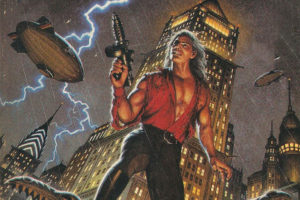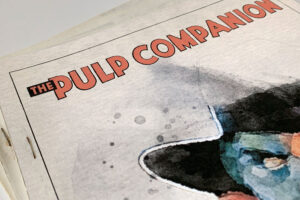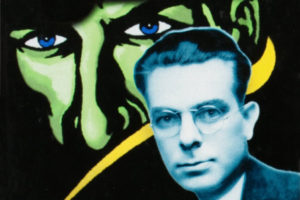A retired pulp fictioneer recalls his life and career.
Donald Barr Chidsey published steadily in the better-paying pulps for over a decade. His stories had many covers, and his total pulp output was prodigious although his major interest was the writing of books, especially non-fiction. A sturdy oak of a man, Chidsey lived in Lyme, Conn., in 1976. A widower in his 70s, Chidsey was living alone, almost reclusively, but continued to write. Writing had been this man’s life, and it still was.
Fanzine flashback
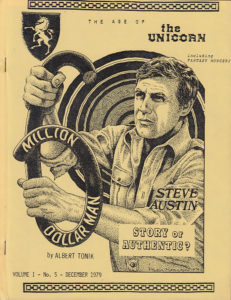
This article originally appeared in Age of the Unicorn (Vol. 1, No. 5; December 1979). It has been slightly edited as it appears here.
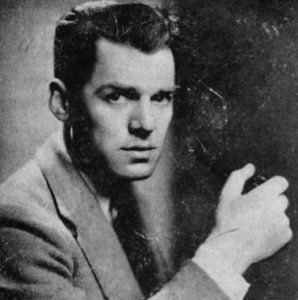
The room in which I visited Chidsey during late summer in 1976 was large, running the full depth of the house, and it was solidly walled with books. A writer’s workshop if ever there was one. At the far end of the room was his typewriter with shelves adjacent to the typewriter-stand for reference books or documents. The other end of the room had an easy chair with readling lamp and record player. A symphony was playing when I entered. A large table, loaded with books,was in the room’s approximate center, and I half-sat on the edge of this during much of my visit… this was a workshop, remember, no conveniences for visitors. Chidsey moved about frequently while we talked.
An early riser, Chidsey cut his own grass in the summer and chopped his own wood in the winter. He seldom left and when he did, it was local travel only, usually to the library at Old Lyme or Hamburg for checking specific references. The previous August, for instance, he was writing a history of the Polk and Tyler administrations… not by contract and no definite publication in view, but a book he must write because he thought there was need for a good readable history of the period.
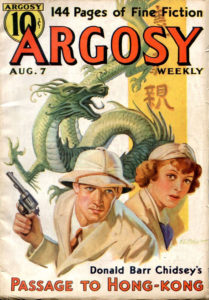
“I went to his hotel in New York and was introduced to him in his suite,” said Chidsey. “At first he orated at me as if he were addressing Parliament, but then he spoke more normally.” When they got around to Marlborough, Churchill described him in antonymic phrases (he was the greatest fighter of his age, yet the most dashing lover… that sort of thing). This rhetoric may sound Churchillian but with a slight shock Chidsey recognized a nearly perfect quotation of the opening paragraph of his biography.
“I had worked hard to create these phrases so I remembered them. I really think that Churchill never realized he was quoting my own book to me. I said nothing to him because I was flattered, no matter how I looked at it,” Chidsey said. They discussed the late war and Churchill crawled on the floor to demonstrate specific points of military strategy. They got along well.
“He gave me a couple of his cigars. I smoked one later and it was no good. The next day I gave the other to a friend and said, ‘Here, have a cigar. Winston Churchill gave it to me yesterday.’ He just stared at me. I don’t think he believed it.” Chidsey grinned at his recollection.
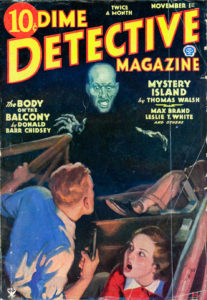
Chidsey autographed one of my books for me (Victory at Yorktown, a history) and apologized for his handwriting. “After all these years of writing, my penmanship was still like an 8-year-old kid’s.” Maybe so, but penmanship is not writing. Chidsey took the first step to a writing career in the ’20s by becoming a tramp newspaperman. Here is a romantic type that has disappeared as totally as the 17th century swordsman. Chidsey entered this vocation immediately after high school graduation, and worked on newspapers throughout the continental United States and Hawaii, including the legendary New York World.
Chidsey knew he could get $35 to $40 weekly as a reporter practically anywhere, so he kept moving, soaking up the atmosphere and experience essential to the writer’s craft… Florida… New Orleans… Denver… Honolulu…. He knew he was going to write books, so he needed this preparation. “All tramp newspapermen want to write books,” he said of this early ambition. “None of us were going to stay reporters.” (Incidentally, during the ’20s he tried out for the U.S. Olympic fencing team and nearly made it.)
The newspaper reporting was sound training, and his drive to publish books was paramount. First was a biography of Bonnie Prince Charlie, then Marlborough, then others — Humphrey Gilbert, Walter Raleigh, John L. Sullivan. After 10 years or so as a tramp newspaperman, Chidsey became a self-supporting freelance writer. In the ’30s, any freelancer could add to his income by writing for the pulps, then a profitable field for trained and disciplined writers. Chidsey’s non-fiction makes logical use of incident and moves swiftly. Writing biography trained him in character development. What more does a pulp writer need?
E. Hoffman Price tells in his introduction to Far Lands, Other Days just how great a triumph it was for a writer to sell to Argosy especially after years of selling to lesser pulps. Black Mask today has classic stature and was in its day perhaps the hardest of all pulps for a writer to break into. Yet Chidsey started his pulp career selling to these magazines, and his productiveness in the pulps for the next decade or so nearly matched that of a Max Brand or H. Bedford-Jones. He favored selling to these pulps for the practical reasons that they paid better and on time.
His pulp fiction ranged through all types except fantastics. Generally he favored crime or detection stories and South Seas locales. His stories are tightly plotted, fast-moving, and written in direct, unembellished prose. Today’s popular TV series, Hawaii Five-O has many stories that could have been written by Chidsey — the same meticulous development of incident, the same precise planning, and the same taut denouement (and the same locale). Generally, he didn’t go in for character series, but there were two. Remember Morton and McGarvey, the dare-devil cops in many Detective Fiction Weekly stories? And Nick Fisher and Eddie Savoy in Argosy, a cop-and-crook combination that to some slight extent anticipated TV’s Switch? These Chidsey characters were highly popular in their day. A third character, Prince Mike of Laos, never caught on quite as well. How, one wonders, can a writer display such continuing inventiveness of plot? Where do the ideas arise?
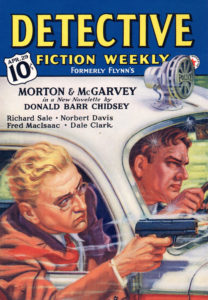
“Oh, I used to pad these stories,” Chidsey told me. I had re-read a number of his stories before visiting him. They weren’t padded and I told him so; if anything, his narrative prose is more spare than that of most pulp writers. “I didn’t pad with words,” he explained. “Never that! But I padded with action. Whenever I was stuck on what would happen next, I had somebody fire a gun, or punch somebody on the jaw. Action — you always added action and plotted it in.” Chidsey made this sound easy.
(Was Chidsey’s use of action actually padding his stories? Chidsey seemed somewhat casual in dismissing so readily his fertility in conceiving plots. Joseph T. Shaw, editor of Black Mask in its days of glory, wrote: “We wanted implicity for the sake of clarity, plausibility, and belief. We wanted action, but we held that action is meaningless unless it involves recognizable human character in three-dimensional form.” Maybe Chidsey’s use of action must be viewed in this light. If so regarded, then when Chidsey said he padded with action he really meant he wrote his story about added elements of action. Definitely not padding, in the lay sense of the word.)
A loner, Chidsey did not mix much with other pulp writers. The Argosy writers I mentioned he knew (MacIsaac, Worts, Roscoe, Mason, Brand, etc.) but as names, not as persons. There were some exceptions; he had met the late Frank Gruber, for instance (Judging from Gruber’s The Pulp Jungle, however, Gruber himself was gregarious in nature). And Chidsey did attend the Black Mask luncheons for authors. These he enjoyed greatly.
“Sam Hammett was chairman, what a guy!” (Sam Hammett? Sam? I checked this later and Hammett really was born Samuel Dashiel Hammett in 1894.) “Nobody called him Dash or Dashiel. He was full of fun.” Obviously liquids flowed without stint at the Black Mask luncheons, and everyone was in festive mood, particularly when led by the sparkling Sam Hammett. Chidsey had scant regard for the somewhat dour pen portrait of Hammett that Lillian Hellman had drawn.
In his pulp writing, Chidsey’s metier was the novelette. He could write long stories, and in fact published many novels but I know of only one serial in Argosy (“Midas of the Mountains,” three parts, Aug. 20 and 27, and Sept. 3, 1938). Probably the novelette-length story was a convenient size for a skillful writer to handle in a money market. Even his short stories read like short novelettes.
The passing of the pulps occurred during and after World War II, and in the immediate post-war years Chidsey went no more a roaming. He married and bought the house in which he still lived. Why a house in Connecticut? His ancestors are in Connecticut. A pre-Revolutionary forefather is buried somewhere in the New Haven green, he told me. The cemetery in Branford, a New Haven suburb and a town more than three centuries old, has a large marble monument near its entrance with the name “Chidsey” on it. It is the solid and large type of tombstone used at about the turn of the century. Locally, the Chidseys were known as an East Haven family, and the name appeared several times in the New Haven phone directory. Lyme is about 30 miles from New Haven.
So, in choosing Connecticut, Don Chidsey was coming home. The war was over, the world was smaller and less romantic, and pulp stories did not fit into the age of jet travel and TV dinners. Now was the time to settle down, to write more books, to become more involved with telling of the past. Among the best of these later books is a series of Revolutionary War titles which analyse incisively the military and social actions of the period, and narrate the story of our national birth in a style that crackles with action. These titles should have been combined in a Bicentennial volume; some publisher missed a sure bet.
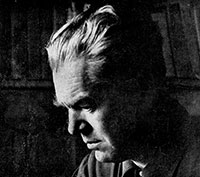
What does a writer read? Apparently reference works, judging from the titles of the books on the walls of Chidsey’s workshop. One large section was devoted exclusively to volumes on crime and its detection, source volumes for the countless crime stories he wrote for the pulps. No longer used, these were in his will as a bequest to the Connecticut State Police. As one would reasonably anticipate, a rather large section of shelving was filled with volumes of his own published works, all first editions, some in leather bindings. But, by and large, his books, including the ones stacked on tables and shelves, were encyclopedia, dictionaries, Thesauri, books on styles in writing, and references. The suspicion arises that writers write, and spend little time in reading or collecting the works of their peers.
His only companions were a sleek and sociable dachshund, and a small and well-groomed cat. The Chidsey attachment to dachshunds was not recent; a photograph of Chidsey rubbing noses with another dachshund appeared on the dust jacket of one of his books. This photo was taken by Boris Artzybasheff, the artist who did so many covers for Time.
Occasionally — then infrequently, he said — Chidsey visited with George Harmon Coxe, another of the pulp greats who also lived in Lyme. Should these two reminesce, one would like to be a fly on the wall… Essentially, though, Chidsey seemed a solitary figure. Hale, dignified, white-haired and serious of mien, he was considered in his movements, deliberate in his speech, carefully using those years left to him. Solitary, yes, but lonesome, no. Ever present was the muse of writing, the irresistable urge of creativity.
“Sometimes I wake up in the morning and I have just the words I want for whatever I’m writing. So I have to get right up and get at it.”
This was a writer speaking. A real professional.
About the author
Alvin H. Lybeck was by profession an industrial chemist, and by pleasure a craftsman who hand-bound books. He wrote around two dozen articles about the pulp magazines that he grew up reading for pulp fanzines late in his life. He died in 2009 at age 90.


